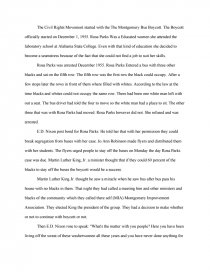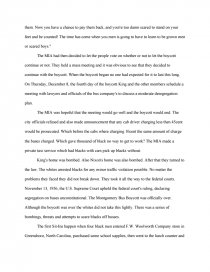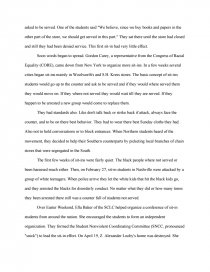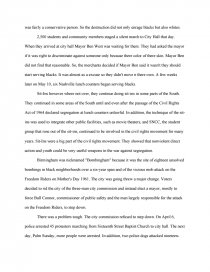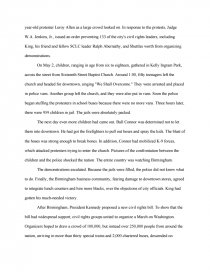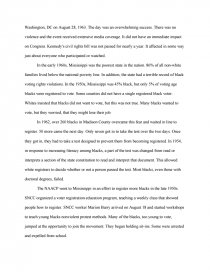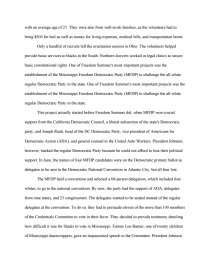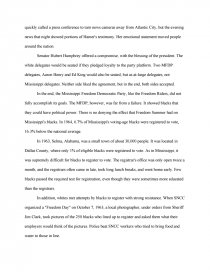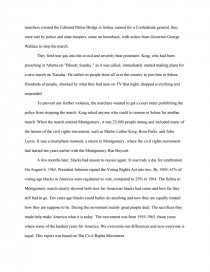Civil Rights Movement
Essay by review • January 14, 2011 • Research Paper • 3,658 Words (15 Pages) • 3,374 Views
The Civil Rights Movement started with the The Montgomery Bus Boycott. The Boycott officially started on December 1, 1955. Rosa Parks Was a Educated women she attended the laboratory school at Alabama State College. Even with that kind of education she decided to become a seamstress because of the fact that she could not find a job to suit her skills.
Rosa Parks was arrested December 1955. Rosa Parks Entered a bus with three other blacks and sat on the fifth row. The fifth row was the first row the black could occupy. After a few stops later the rows in front of them where filled with whites. According to the law at the time blacks and whites could not occupy the same row. There had been one white man left with out a seat. The bus driver had told the four to move so the white man had a place to sit. The other three that was with Rosa Parks had moved. Rosa Parks however did not. She refused and was arrested.
E.D. Nixon post bond for Rosa Parks. He told her that with her permission they could break segregation from buses with her case. Jo Ann Robinson made flyers and distributed them with her students. The flyers urged people to stay off the buses on Monday the day Rosa Parks case was due. Martin Luther King, Jr. a minister thought that if they could 60 percent of the blacks to stay off the buses the boycott would be a success.
Martin Luther King Jr. thought he saw a miracle when he saw bus after bus pass his house with no blacks in them. That night they had called a meeting him and other ministers and blacks of the community which they called there self (MIA) Montgomery Improvement Association. They elected King the president of the group. They had a decision to make whether or not to continue with boycott or not.
Then E.D. Nixon rose to speak: "What's the matter with you people? Here you have been living off the sweat of these washerwomen all these years and you have never done anything for them. Now you have a chance to pay them back, and you're too damn scared to stand on your feet and be counted! The time has come when you men is going to have to learn to be grown men or scared boys."
The MIA had then decided to let the people vote on whether or not to let the boycott continue or not. They held a mass meeting and it was obvious to see that they decided to continue with the boycott. When the boycott began no one had expected for it to last this long. On Thursday, December 8, the fourth day of the boycott King and the other members schedule a meeting with lawyers and officials of the bus company's to discuss a moderate desegregation plan.
The MIA was hopeful that the meeting would go well and the boycott would end. The city officials refused and also made announcement that any cab driver charging less then 45cent would be prosecuted. Which before the cabs where charging 10cent the same amount of charge the buses charged. Which gave thousand of black no way to get to work? The MIA made a private taxi service which had blacks with cars pick up blacks without.
King's home was bombed. Also Nixon's home was also bombed. After that they turned to the law. The whites arrested blacks for any minor traffic violation possible. No matter the problems they faced they did not break down. They took it all the way to the federal courts. November 13, 1956, the U.S. Supreme Court upheld the federal court's ruling, declaring segregation on buses unconstitutional. The Montgomery Bus Boycott was officially over. Although the boycott was over the whites did not take this lightly. There was a series of bombings, threats and attempts to scare blacks off busses.
The first Sit-Ins happen when four black men entered F.W. Woolworth Company store in Greensboro, North Carolina, purchased some school supplies, then went to the lunch counter and asked to be served. One of the students said "We believe, since we buy books and papers in the other part of the store, we should get served in this part." They sat there until the store had closed and still they had been denied service. This first sit-in had very little effect.
Soon words began to spread. Gordon Carey, a representative from the Congress of Racial Equality (CORE), came down from New York to organize more sit-ins. In a few weeks several cities began sit-ins mainly in Woolworth's and S.H. Kress stores. The basic concept of sit-ins students would go up to the counter and ask to be served and if they would where served them they would move on. If they where not served they would wait till they are served. If they happen to be arrested a new group would come to replace them.
They had standards also. Like don't talk back or strike back if attack, always face the counter, and to be on there best behavior. They had to wear there best Sunday cloths they had. Also not to hold conversations or to block entrances. When Northern students heard of the movement, they decided to help their Southern counterparts by picketing local branches of chain stores that were segregated in the South.
The first few weeks of sit-ins were fairly quiet. The black people where not served or been harassed much either. Then, on February 27, sit-in students in Nashville were attacked by a group of white teenagers. When police arrive they let the white kids that hit the black kids go, and they arrested the blacks for disorderly conduct. No matter what they did or how many times they been arrested there still was a counter full of students not served.
Over Easter Weekend, Ella Baker of the SCLC helped organize a conference of sit-in students from around the nation. She encouraged the students to form an independent organization. They formed the Student Nonviolent Coordinating Committee (SNCC, pronounced "snick") to lead the sit-in effort. On April 19, Z. Alexander Looby's home was destroyed. She was fairly a conservative person. So the destruction did not only enrage blacks but also whites.
2,500 students and community members staged a silent march to City Hall that day. When they arrived at city hall Mayor Ben West was waiting for them. They had asked the mayor if it was right to discriminate against someone only because there color of there skin. Mayor Ben did not find that reasonable. So, the merchants decided if Mayor Ben said it wasn't they should start serving blacks. It was almost as a excuse so they didn't move n there own. A few weeks later on May 10, six Nashville lunch counters began serving blacks.
Sit-Ins however where not over, they continue doing sit-ins in some parts of the South. They continued in some areas of the South until and even after the passage of the Civil Rights Act of 1964 declared segregation at lunch counters unlawful. In addition, the technique of the sit-ins was used to integrate other public facilities, such as movie theaters, and SNCC, the student
...
...
